Cloud security is a very crucial. Our cloud “volume” comes to life when someone somewhere in a data center watches over the blade server running a cloud instance, which is responsible for deploying applications and data services into the cloud. This is great and all, but in the future of AI and autonomous computing, we will be much more efficient if we remove the “somebody somewhere” from the above equation, at least partially.
A Fix For Cloud Issues:
Since things become risky when dealing with cloud robustness issues brought on by malware, poorly installed code, misaligned cloud connection points, or simple misconfiguration, we track the time required to fix these issues. This window, which is also known as the Mean Time To Remediation (MTTR) or the vulnerability resolution window, is becoming even more constrained in mission-critical cloud-native systems.
With today’s state-of-the-art CI/CD processes, software code can be pushed to “live” cloud production settings numerous times a day. This makes it possible to open any security holes caused by misconfigurations, vulnerabilities, or other problems at the same rate. How might AI, considering these basics, strengthen our cloud?
Engineers in software application development and operations must learn to work together more efficiently to detect and fix key problems more rapidly in a world where threats are changing at an unprecedented rate. Aqua Security’s chief product officer, Gilad Elyashar, claims that it can be challenging to develop efficient DevSecOps cooperation frameworks due to the complexity of deciding where and how to allocate resources.
 Different Types Of Issues:
Different Types Of Issues:
The objective, he argues, is straightforward for today’s cloud-centric, cloud-native, cloud-first software engineers. Security holes and possible attack pathways that represent the biggest threat to the company can be filled before release by improving the process of finding and correcting vulnerabilities and misconfigurations upfront in the development lifecycle. Still, that’s only part of the obstacle. In addition to facilitating the discovery and mitigation of application code vulnerabilities, teams must assist developers in overcoming the various obstacles that arise during the remediation process.

“That’s where AI-guided remediation can help,” Elyashar stated. The average amount of time it takes for attackers to exploit a vulnerability after its discovery is now just fifteen days, according to the Cybersecurity and Infrastructure Security Agency (CISA) of the US. When this accelerated time-to-exploit is coupled with the expanding quantity of rapidly emerging vulnerabilities, the attack potential for publicly accessible cloud applications is significantly augmented. And it is immediately clear how important it is to decrease the MTTR. But up until this point, developers and the security teams have had a hard time figuring out how to accomplish this goal together.
The DevSecOps Mystery Solved:
According to the Aqua crew, the development and security teams are both overwhelmed by the sheer number of vulnerabilities. Problems with efficiently fixing all important issues across teams get worse by the seemingly endless backlog of code-brd vulnerabilities. Many experts in the field are already pointing to potential areas where generative AI could revolutionize vulnerability repair. According to Elyashar, development, and security teams can benefit from prescriptive remediation steps that are automatically generated when dealing with misconfigurations and vulnerabilities in container images and other artifacts. These steps can be applied across various clouds and workload types.

“Highly adept at automating code analysis and generating potential fixes for security vulnerabilities, these powerful Large Language Models (LLMs) make it possible to speed time-to-remediation while reducing developer workloads,” he said. He explained, “By using AI-guided remediation, CISOs can ensure that developers, who may not be security experts, receive the prescriptive contextual guidance that will empower them to remediate quickly and efficiently. With AI-guided remediation in play, developers and security teams no longer need to spend countless hours manually reading advisories, searching for patches, or building verification steps before acting. Instead, AI guides them with clear and concise instructions on how to complete the fix.”
Speeding Up The Fix:
With the help of LLMs’ predictive capabilities, developers can find bugs in their code more consistently and easily, all while writing code. With AI-guided remediation, developers can stop wasting time trying to figure out how to fix things and instead concentrate on making progress.
According to Elyashar, AI-guided remediation helps strengthen development and security team processes by bridging the gap between the two groups. This change removes many of the typical sources of tension between teams and paves the way for enhanced cooperation and shared ownership in DevSecOps duties.
AI-guided remediation allows security teams to resolve vulnerabilities and misconfigurations faster, according to Aqua’s Elyashar. It also promotes a culture of shared ownership and better collaboration among developers and security specialists. He explained that Minimizing risk exposure is made possible by this innovative AI-powered capability, which provides detailed guidance on how to fix issues, thereby dramatically reducing MTTR for security teams.
Relief From Remedial Headaches:
By leveraging the capabilities of generative AI to empower code builders and code defenders to operate more efficiently and accomplish more tasks, the expectation is that this will alleviate the strain on security teams, which have traditionally been tasked with completing remediation details for every identified vulnerability instance.
As cyber threats continue to increase at a dizzying rate, AI-guided remediation is being proposed as a way for developers of software applications, who might not be security experts, to acquire the contextual guidance they require to work together and remediate swiftly. Even if AI isn’t quite the “electronic security expert in your pocket” that software sausage vendors claim it is, it can nevertheless speed up problem-solving and lead users to safer cloud experiences.





